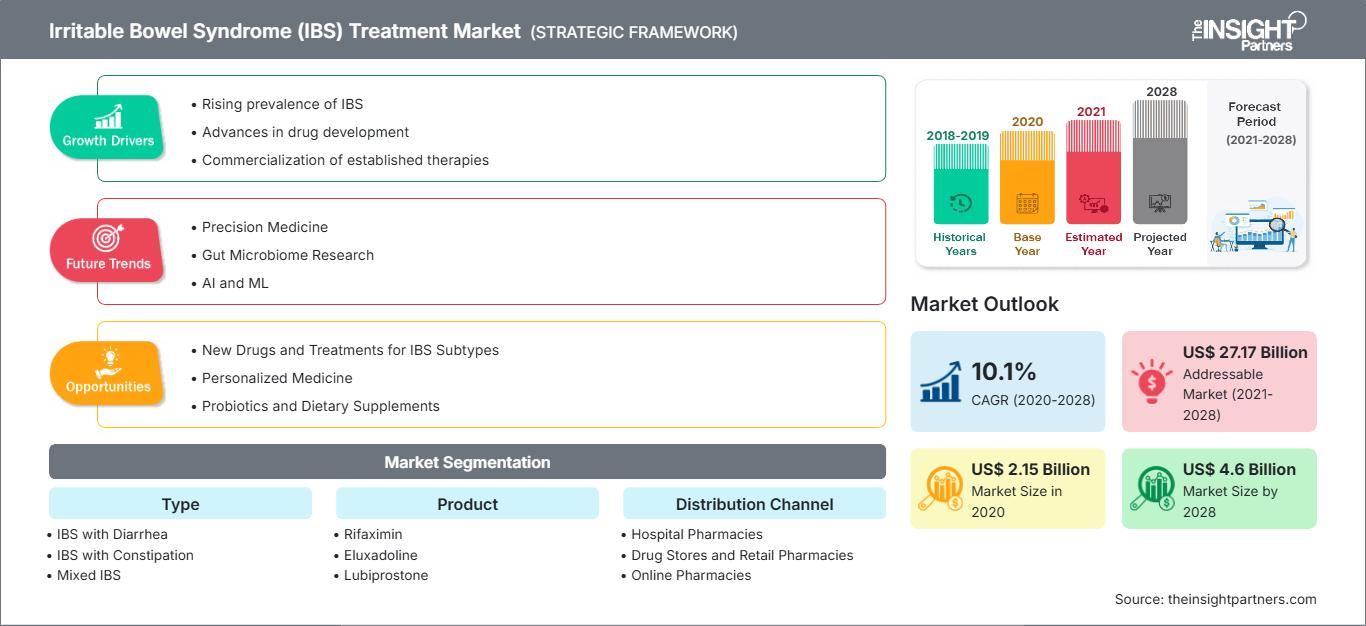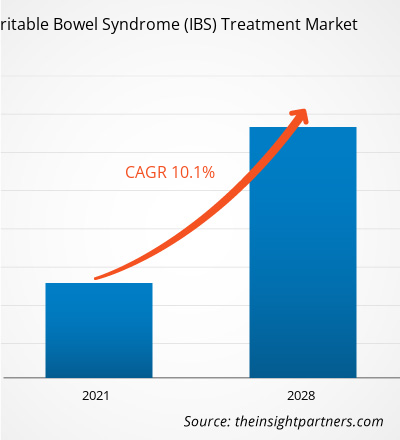2020 年,肠易激综合征 (IBS) 治疗市场价值 21.5389 亿美元,预计到 2028 年将达到 46.003 亿美元;预计 2021 年至 2028 年的复合年增长率为 10.1%。
肠易激综合征疾病患病率的上升和研发活动的增多等主要因素推动了市场的增长。然而,产品数量有限和治疗效率低下抑制了市场的增长。IBS 是一种常见的慢性疾病,会影响腹部器官和大肠。它也被称为痉挛性结肠、粘液性结肠炎、肠易激综合征和痉挛性结肠炎。这种疾病与炎症性肠病有很大不同。其症状包括痉挛、腹痛、腹胀、胀气、腹泻或便秘,或两者兼有。如果症状较轻,可以通过改变压力、生活方式和饮食来控制。如果症状严重,则可以通过药物治疗和心理咨询来治疗。
亚太地区已采取多项措施来遏制导致 COVID-19 的新型冠状病毒的传播。这些措施扰乱了各行各业许多公司的运营,包括医疗保健行业。员工隔离、供应链中断以及需求减少给公司带来了严重的问题。此外,私立医院的住院和门诊治疗量也大幅下降。为了减轻医疗系统的负担,许多诊所正在推迟非危重症的预约。这种情况阻碍了肠易激综合征 (IBS) 治疗的发展。
自定义此报告以满足您的要求
您将免费获得任何报告的定制,包括本报告的部分内容,或国家级分析、Excel 数据包,以及为初创企业和大学提供超值优惠和折扣
肠易激综合征(IBS)治疗市场: 战略洞察

- 获取本报告的主要市场趋势。这个免费样本将包括数据分析,从市场趋势到估计和预测。
您将免费获得任何报告的定制,包括本报告的部分内容,或国家级分析、Excel 数据包,以及为初创企业和大学提供超值优惠和折扣
肠易激综合征(IBS)治疗市场: 战略洞察

- 获取本报告的主要市场趋势。这个免费样本将包括数据分析,从市场趋势到估计和预测。
市场洞察
肠易激综合征及相关疾病的患病率不断上升
肠易激综合征是一种常见的慢性胃肠道疾病,由排便习惯紊乱和腹痛引起。这种疾病也称为痉挛性结肠、过敏性结肠、粘液性结肠炎和痉挛性结肠炎。肠易激综合征的症状包括腹痛、便秘、腹泻和腹部绞痛。各地区的卫生系统都见证了肠易激综合征发病率的大幅增长。国际胃肠病基金会发布的数据显示,在所有 IBS 患者中,约 40% 的患者患有轻度 IBS,约 35% 的患者患有中度 IBS,估计 25% 的患者患有重度 IBS。许多人没有意识到肠易激综合征 (IBS) 的症状。
某些因素,例如食物过敏、胃肠炎的发展阶段、结肠不规律运动、结肠中血清素的异常成分以及轻度乳糜泻,都是可能导致 IBS 的风险因素。预计这些因素将加速全球 IBS 的患病率。例如,根据 2018 年 NCBI 发表的一项研究,估计 IBS 每年影响约 10% 至 16% 的美国人口。如此惊人的 IBS 患病率可能会在预测期内提振肠易激综合征 (IBS) 治疗市场。
基于类型的洞察
根据类型,肠易激综合征 (IBS) 治疗市场细分为混合型 IBS (IBS-M)、腹泻型 IBS (IBS-D) 和便秘型 IBS (IBS-C)。 2020 年,混合型肠易激综合征 (IBS-M) 占据了最大的市场份额。此外,预计同一细分市场在预测期内的复合年增长率最高。预计男性和女性 IBS 患病率的上升将推动对治疗便秘和腹泻综合症状的药物的需求。老龄化人口中 IBS 的患病率更高。因此,在预测期内,对治疗混合型 IBS 的药物的需求可能会大幅增长。
基于产品的洞察
根据产品,肠易激综合征 (IBS) 治疗市场细分为利福昔明、依鲁沙多林、鲁比前列酮、利那洛肽等。利那洛肽细分市场在 2020 年占据了最大的市场份额。此外,预计同一细分市场在预测期内的复合年增长率最高。该细分市场的成长归因于多种因素,例如利那洛肽仿制药产量的增加,以及利那洛肽用于治疗肠易激综合征 (IBS) 的开发和商业化市场整合的加剧。
基于分销渠道的洞察
根据分销渠道,肠易激综合征 (IBS) 治疗市场细分为医院药房、药店和零售药店以及在线药店。2020 年,医院药房占据了最大的市场份额。然而,预计药店和零售药店细分市场在预测期内的复合年增长率最高。
肠易激综合征 (IBS) 治疗市场的公司采用产品创新战略,以满足全球不断变化的客户需求,这也使他们能够在全球市场上保持自己的品牌。
肠易激综合征 (IBS) 治疗市场区域洞察
The Insight Partners 的分析师已详尽阐述了预测期内影响肠易激综合征 (IBS) 治疗市场的区域趋势和因素。本节还讨论了北美、欧洲、亚太地区、中东和非洲以及南美和中美洲的肠易激综合征 (IBS) 治疗市场细分和地域分布。
肠易激综合征(IBS)治疗市场报告范围
| 报告属性 | 细节 |
|---|---|
| 市场规模 2020 | US$ 2.15 Billion |
| 市场规模 2028 | US$ 4.6 Billion |
| 全球复合年增长率 (2020 - 2028) | 10.1% |
| 历史数据 | 2018-2019 |
| 预测期 | 2021-2028 |
| 涵盖的领域 |
By 类型
|
| 覆盖地区和国家 | 北美
|
| 市场领导者和主要公司简介 |
|
肠易激综合征 (IBS) 治疗市场参与者密度:了解其对业务动态的影响
肠易激综合征 (IBS) 治疗市场正在快速增长,这得益于终端用户需求的不断增长,而这些需求的驱动因素包括消费者偏好的演变、技术进步以及对产品益处的认知度的提升。随着需求的增长,企业正在扩展产品线,不断创新以满足消费者需求,并抓住新兴趋势,从而进一步推动市场增长。

- 获取 肠易激综合征(IBS)治疗市场 主要参与者概述
肠易激综合征 (IBS) 治疗市场 — 按类型
- 腹泻型肠易激综合征 (IBS-D)
- 便秘型肠易激综合征 (IBS-C)
- 混合型肠易激综合征 (IBS-M)
肠易激综合征 (IBS) 治疗市场 — 按产品
- 利福昔明
- Eluxadoline
- 利那洛肽
- 鲁比前列酮
- 其他
肠易激综合征 (IBS) 治疗市场 —按分销渠道
- 医院药店
- 药店和零售药店
- 网上药店
肠易激综合征 (IBS) 治疗市场–按地理位置
北美洲
- 美国
- 加拿大
- 墨西哥
欧洲
- 法国
- 德国
- 意大利
- 英国
- 西班牙
- 其他地区欧洲
亚太地区 (APAC)
- 中国
- 印度
- 韩国
- 日本
- 澳大利亚
- 亚太地区其他地区
中东和非洲 (MEA)
- 南部非洲
- 沙特阿拉伯
- 阿联酋
- 中东和非洲其他地区
南美洲和中美洲(SCAM)
- 巴西
- 阿根廷
- 其余 SCAM
公司简介
- Ironwood Pharmaceuticals, Inc.
- AbbVie。
- Sebela Pharmaceuticals, Inc.
- 武田制药有限公司
- Alfasigma SpA
- 安斯泰来制药公司
- 阿斯利康
- Synthetic Biologics, Inc.
- 博士伦公司
- Lannett Company Inc
- 历史分析(2 年)、基准年、预测(7 年)及复合年增长率
- PEST和SWOT分析
- 市场规模、价值/数量 - 全球、区域、国家
- 行业和竞争格局
- Excel 数据集
近期报告
客户评价
购买理由
- 明智的决策
- 了解市场动态
- 竞争分析
- 客户洞察
- 市场预测
- 风险规避
- 战略规划
- 投资论证
- 识别新兴市场
- 优化营销策略
- 提升运营效率
- 顺应监管趋势




















 获取免费样品 - 肠易激综合征(IBS)治疗市场
获取免费样品 - 肠易激综合征(IBS)治疗市场